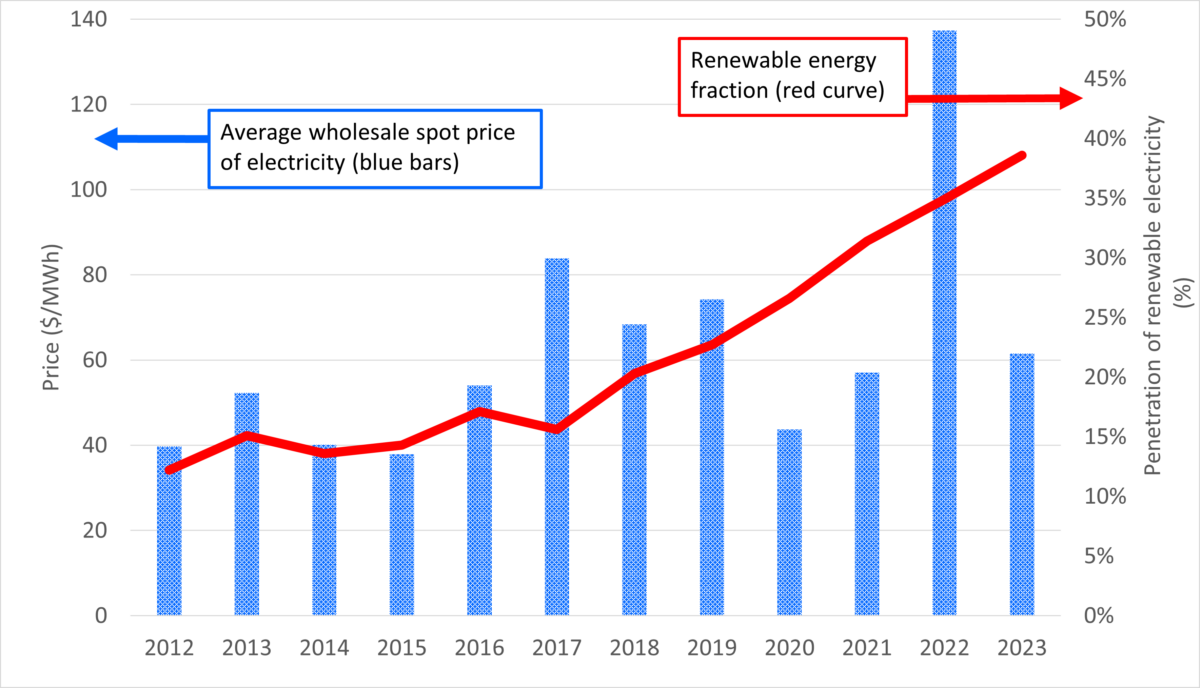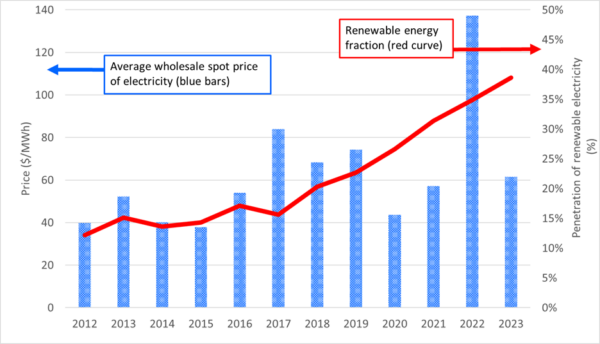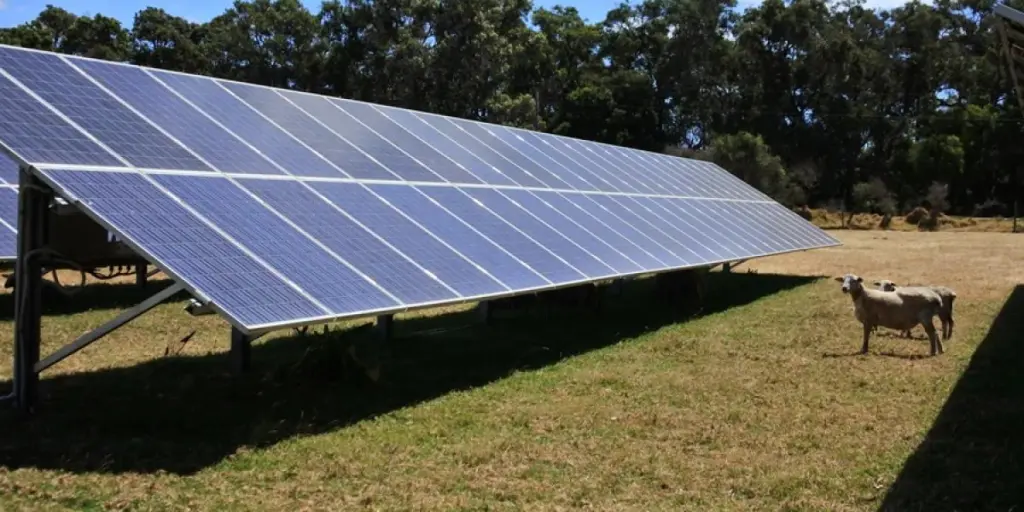Australia currently has about 40% renewable electricity, mostly solar and wind. This is not causing wholesale spot prices to change, nor destabilizing the grid. On current policy settings, the country will reach 82% renewable electricity in 2030.

Australia is generating more solar electricity per person than any other country: about 2 Megawatt-hours per person per year. It is interesting to examine the impact of widespread deployment of PV (and wind) on wholesale electricity prices.
Most of the Australian population lives on the eastern seaboard and is served by the National Electricity Market (NEM). This comprises a distribution system some 3000 kilometres long, but only a few hundred kilometres wide, and serves about 20 million people. There is no connection to other electricity grids and so the NEM must “go it alone” with sufficient storage. Solar and wind electricity cannot be traded for fossil, nuclear or hydroelectricity from other countries.
In 2023, generation shares in the NEM were coal (56%), solar (18%), wind (13%), hydro (7%) and other fossil fuels (6%). New fossil fuel capacity deployment essentially stopped a decade ago, and solar and wind deployment rapidly accelerated from 2018. The NEM is a relatively open electricity market. People can freely connect to the NEM provided that safety and grid stability requirements are met. The solar and wind shares are rapidly rising as private companies and individuals take advantage of the low and declining cost of renewable electricity. Australian grid stability is excellent.
Figure 1 shows the average NEM wholesale electricity spot price (blue bars) and the renewable electricity fraction (red line) over the 12-year period 2012-2023. Prices are corrected for inflation and are translated into current US dollars.

There is no obvious correlation between the electricity market spot price and the rise and rise of solar and wind. Australia is a major exporter of coal and gas, and world parity prices prevail in Australia. The large price spike in 2022 and into 2023 mirrored the global price spike in fossil fuels following the Russian invasion of Ukraine.
In an alignment of political, environmental and economic good sense, the Australian Government and all the provincial governments agree that rapid progress towards a renewable-dominated grid is required. Considerations include: all Australian regions have access to good wind and/or solar; the largest risk to stability of electricity supply is a sudden and unexpected failure of coal power stations, most of which are reaching the end of their technical lives.; the largest risk of future price spikes similar to 2022 comes from global fossil fuel market prices; and the easiest and quickest way to make large reductions in emissions to help meet international greenhouse commitments is to push coal and gas out of electricity production.
Rooftop solar is being deployed by millions of house owners and businesses, driven by the very low cost of rooftop solar electricity compared with the retail tariff. About one third of houses now has a rooftop solar system. Solar farms and wind farms are being widely deployed close to existing transmission. However, it is proving difficult to deploy new transmission to service new solar and wind farms due to local opposition. This creates risk for solar and wind farm developers. This problem is being mitigated through sharply increased compensation for hosts of new transmission, and the development of renewable energy zones (REZ) with dedicated transmission corridors.
Although solar and wind have a compelling cost advantage over fossil fuel alternatives, there are serious risks with adequate transmission and storage. Recently, the national Government decided to mitigate risks by holding reverse auctions every six months for new solar and wind capacity. These auctions entail companies competing for a specified price range for electricity. If wholesale electricity prices are below the price range, then the government will make up the difference. If prices are above the price range, then the difference is payable to the government. Companies that offer a lower price than competitors will generally win a contract, which puts downwards pressure on prices. Sufficient capacity will be auctioned over 2024-27 to reach the Government target of 82% renewable electricity in 2030.
Author: Prof. Andrew Blakers /ANU
Andrew.blakers@anu.edu.au
ISES, the International Solar Energy Society is a UN-accredited membership NGO founded in 1954 working towards a world with 100% renewable energy for all, used efficiently and wisely.
The views and opinions expressed in this article are the author’s own, and do not necessarily reflect those held by pv magazine.
This content is protected by copyright and may not be reused. If you want to cooperate with us and would like to reuse some of our content, please contact: editors@pv-magazine.com.
Source from pv magazine
Disclaimer: The information set forth above is provided by pv-magazine.com independently of Alibaba.com. Alibaba.com makes no representation and warranties as to the quality and reliability of the seller and products.




